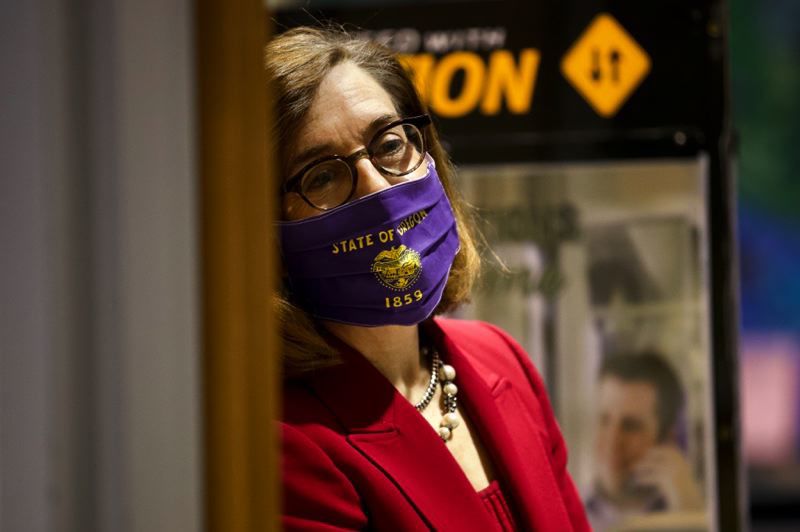Gov. Brown will lift most COVID-19 limits if 70% of state is vaccinated
Published 11:09 am Tuesday, May 11, 2021

- PMG PHOTO: JAIME VALDEZ - Gov. Kate Brown, at a May press event, wearing her social distancing mask in public.
Gov Kate Brown laid out some basic math on Tuesday for Oregon’s way out of pandemic restrictions: Get 70% of adult residents at least one shot of vaccine and “normalcy” can start to return as early as next month.
“Let’s get this done, let’s get our economy open, and enjoy the summer,” Brown said during an afternoon press call.
The state has administered at least one shot to about 57% of those eligible. Both state and federal health officials refer to vaccinating “adults,” but the term covers all those age 16 and over – the minimum age for vaccinations for now.
Most inoculations in Oregon have been with the Pfizer and Moderna two-shot vaccine, with doses administered about a month apart. A limited number of one-shot Johnson & Johnson doses have also been administered.
Oregon Health Authority Director Pat Allen said the state needed to get one shot into the arms of about 430,000 more people to reach the 70% vaccination goal by June.
Brown’s announcement does not mean the lifting of all restrictions.
If the targets are met, the state’s lower risk level restrictions would be observed. While expanding options for restaurants, bars, sports, gyms, businesses and gatherings, it often limits capacity to 50% of normal.
The announcement marked a major policy shift in which vaccination rate will now be the key measure of a county’s ability to drop COVID-19 restrictions.
Individual counties could move out of restrictions even earlier under the new policy.
Counties could apply for the removal of restrictions early next week if they can show 65% of residents 16 and older have started the vaccination process. If approved, restrictions could be curtailed starting May 21.
Counties must also submit a “vaccine equity” plan on how to get vaccine opportunities to people in underserved communities.
Benton and Hood River counties have already exceeded the 65% vaccination threshold. Deschutes, Multnomah, Washington, and Lincoln counties are above 60%.
OHA officials said some counties with high vaccination rates and low infection counts, such as Clatsop County, could quickly move out of the restrictions next two weeks if vaccination goals are met
The new emphasis on vaccination levels means counties could move out of most restrictions despite high infection rates this week.
Deschutes County reported 542.6 cases per 100,000 people this week, the second highest of Oregon’s larger counties behind only Klamath County. But if it hits the 65% mark, it moves to lower risk no matter what its infection rates.
Allen said that high vaccination rates were more important than high infection rates in determining progress against COVID-19. Even if infection rates are high, vaccination rates above 65% meant that cases were unlikely to result in severe illness or death.
On the flip side, if the state reaches a 70% overall vaccination rate, even counties where vaccination rates are at the low end of the statewide scale would move out of the restrictions along with all other counties.
OHA reported Tuesday that just 32% of residents in Umatilla and Malheur counties were vaccinated. Sparsely populated Lake County has the lowest vaccination rate at 31%.
Douglas is the only county with over 100,000 population to have a sub-40% vaccination rate. It’s currently listed by OHA at 37%.
Other counties that OHA lists as having 40% vaccination rates include Morrow, Union, Grant, Harney, and Gilliam,
Asked if meeting the 70% vaccination goal would likely mean that the Pendleton Round-Up could be held in September, Brown was upbeat.
“Let ‘er buck,” Brown forecast.
While the Centers for Disease Control may suggest some mask requirements, most likely the event would go off much closer to normal than forecast earlier. The Round-Up was cancelled last year because of Covid-19 concerns.
Brown said the new guidelines were possible because data showing the most recent spike in cases over the past month has begun to fade.
After regularly ranking in the half dozen states with the lowest levels of infection and deaths relative to other states, Oregon saw a sharp spike in the second half of April.
Late last month, Oregon’s rate of new infections grew 53% over a two-week period, according to a New York Times infection database updated every 24 hours. Oregon’s new case rate has fallen 14% in the past two weeks.
Oregon is averaging 17 new infections per day over the past two weeks – putting it in 11th place among the states. The national average is 12 cases per day.
Brown said the trends meant it was time to move forward with allowing looser restrictions if vaccination levels continued to climb.
“It looks like we’ve crossed the tipping point of the fourth surge,” Brown said. “Our hospitalization rates have stabilized. Our infection rates are on a downward trajectory. And in the race between vaccines and variants, our efforts to vaccinate Oregonians are taking the lead.”
Brown said she was confident the statewide vaccination goal to reopen the entire state by mid-June was in reach if residents stepped-up to get vaccinated and help others get their shots, too.
Oregon is increasing walk-in and local clinic efforts in an attempt to get what national infectious disease officials call “impulse vaccinations” by people who did not want to deal with the burden of prior online registration.
After achieving 70% statewide vaccination of adults, Oregon may continue requiring some use of masks and physical distancing, Brown said. The decision will be based on recommendations from the Centers for Disease Control and Prevention.
All other health and safety requirements for counties under the state’s risk level framework would be lifted, and counties would no longer be assigned differing risk levels.
The changes don’t affect some specific areas.
Oregon public schools would still follow the state’s “Ready Schools, Safe Learners” protocols, which will be updated before the upcoming return to school in the fall with an eye on removing those restrictions where possible with CDC guidance.
The University of Oregon and Western Oregon University announced this week that students would have to be vaccinated against COVID-19 in order to attend classes in person this fall. Oregon State University and Portland State University had announced the same policy earlier.
Gov. Kate Brown released the now-weekly list of COVID-19 risk levels for Oregon’s 36 counties Tuesday.
Though the number of COVID-19 hospitalizations has remained above 300 this week, the most restrictive “extreme risk” limits were waived again because cases did not increase by 15%.
Any changes to status announced Tuesday would go into effect on Friday, May 14.
For more information, go to covidvaccine.oregon.gov or call 211.
Current county risk levels as of Friday, May 14:
Lower Risk (8)
Gilliam
Harney
Lake
Morrow
Sherman
Union
Wallowa
Wheeler
Moderate Risk (7)
Coos
Curry
Grant (Moved from High)
Hood River
Lincoln (Moved from High)
Tillamook
Wasco (Moved from High)
High Risk (21)
Baker
Benton
Clackamas
Clatsop
Columbia
Crook
Deschutes
Douglas
Jackson
Jefferson
Josephine
Klamath
Lane
Linn
Malheur
Marion
Multnomah
Polk
Umatilla
Washington
Yamhill





